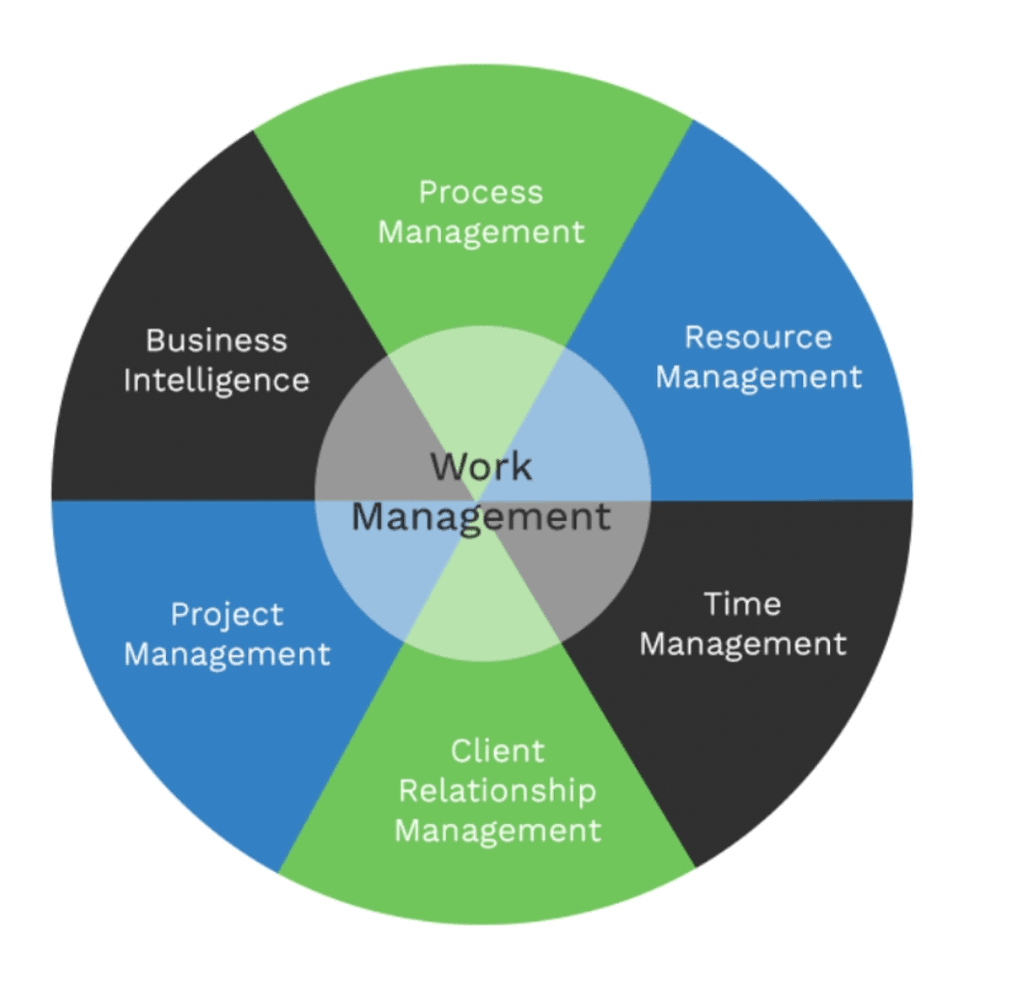A work management system streamlines business processes and optimizes personnel performance to meet management objectives. As a business grows, management objectives become more complex. Optimum productivity and quality results are possible using work management systems whose primary function is to help business leaders deliver high-quality products and services.
Table of Contents
ToggleWhat is Work Management?
According to Gartner, a leading research and advisory firm in business and technology, work management is a set of software and services that manage and transform key business processes to improve results and performance continuously.
Work management intertwines and can be confused with project management due to the use of similar collaboration tools. The main difference is that work management helps teams manage direct and indirect aspects of the business such as projects, work processes, routine tasks, and performance management. On the other hand, project management is an aspect within work management that focuses specifically on managing individual projects.
Scope of a Work Management System
A work management system covers all functions that can be automated within an organization, as indicated in the image below:

(Image source: scoro.com)
What Are the Basic Objectives of a Work Management System?
The primary objectives of a work management system are the objectives of business management. To understand the objective of a work management system, you have to know what aspects of a business need to be managed, streamlined, and automated. This approach allows you to tailor your work management system to your business’s specific needs and achieve your desired results.
An effective work management system will help you improve productivity, organize project and non-project tasks, and automate repetitive processes. To be more specific, the aspects below are what a sound work management system should provide. These are sub-systems within the overall work management system implemented in a business to ensure all functions are running smoothly.
Personnel Management
The primary objective of personnel management is the optimum utilization of human resources in an organization to achieve its goals and objectives.
A work management system helps in this regard by enabling you to automate and manage repetitive functions that free up staff to focus on core tasks. For example, a system that allows employees to access functions like leave applications remotely without having to engage with HR personally eliminates time wastage that an employee would spend engaging the HR team via email or telephone.
Performance Management
Another objective of the work management system is to meet the objectives of performance management. Employee performance tracking is an essential aspect of work management. The system should enable line managers to maintain a continuous workflow across the workforce, track their team’s performance (as a whole and individually), and identify improvement areas.
Project Management
Project management is the application of skills, knowledge, tools, and techniques to plan and implement projects. The work management system should help project managers initiate project plans, allocate resources, track budgets, conduct project audits, share project updates with management, manage multiple portfolios and retrieve customized reports. With the sudden surge in remote working experienced in 2020, smooth management of projects and accompanying teams has become more crucial than ever to meet project timelines.
Client Relationship Management
The work management system should enable your business development teams to manage their clients better to ensure continuous business inflows. A client/customer relationship management system is usually integrated within the overall work management system so that other team members can access interactions between a client and the business’s employees. The system helps manage sales, provide business insights, track workflow among the sales team, generate sales reports and ensure clients’ queries and complaints are handled accordingly. Client management is also a strategy for learning your clients’ needs better in order to tailor your services accordingly and maintain stronger relationships that are mutually beneficial. This can be achieved through collating and analyzing client data retrieved from the work management system and identifying problems from that data that you can solve within your business.
Time Management
Effective time management is a major objective of personnel management. When employees spend time on core tasks and utilize company time efficiently, the organization prospers. A work management system helps ensure that employees don’t waste company time and work efficiently. A major area for time management is clock-in and checkouts. This streamlines how teams plan their work. Clock-ins and checkouts also help managers see the available capacity for future planning. Managers can also control overtime costs and monitor work delivery timelines.
Centralized time management also ensures your remote workforce gets work done with minimal supervision while accommodating different time zones.
Team Collaboration
Another objective of work management systems is to reduce the number of work applications employees need to do their jobs. Working with too many applications fragments team collaboration leading to miscommunication and confusion. Working with multiple applications also throws off team alignment and reduces efficiency. According to a 2020 study by Asana, employees are working across ten apps 25 times a day, leading to reduced efficiency. Centralizing all your work processes helps your teams work together more efficiently while also preventing burnout from application overload.
Financial Management
A key component of work management is financial management. An effective system should track and manage expenses, manage vendor and supplier payments and provide insights into your organization’s financial health.
Knowledge Management
This is the deliberate process of organizing, retaining, and sharing the knowledge, ideas, skills, and experiences of an organization’s workforce. A robust knowledge management process within the work management system enables faster decision-making, planning, and execution. Organizing an organization’s knowledge improves productivity by cutting down the time taken to do information searches.
Identifying a Good Work Management System
Having covered a work management system’s main objectives, let’s look into how to identify a good work management system. These factors help you know if a system meets the criteria for managing your business and if it’s worth the investment.
- Helps you maintain control over your time: A good system should remove the hassle of managing repetitive tasks so you and your teams can focus on much more important work. The system should also help your team meet their work deadlines by giving regular updates on their project and quickly responding to issues that come up mid-project, all in a centralized platform without the need for holding multiple status meetings.
- Managing tasks: You will likely have multiple projects running simultaneously, so your work management system should provide a structured and organized way of monitoring tasks and visualizing your workflows. This is a basic feature that all work management systems should provide.
- Collaboration: The ability to collaborate with multiple teams on various projects is a necessary feature. Employees should share files, approve documents and share feedback seamlessly on tasks and projects.
- Improves financial management processes: A sound work management system should help streamline your costs, revenue and provide business performance insights.
- Remote accessibility: Crucial,as more businesses transform their operations to accommodate remote working.
Top 10 Work Management Tools
Now that you understand the main management objectives of a work management system and the criteria for selecting a sound one, which are the best platforms to automate your work processes? The ten software applications listed below have high ratings from clients across the globe.
Trello
According to the company’s website, Trello has helped more than 1 million teams worldwide manage their work processes. Launched in 2011, it has since developed reliable tools to manage work processes through its workflow automation app known as Butler. You can also integrate other applications like Slack, Email, and Jira to centralize your communication across the board.
Scoro
Another favorite with businesses is Scoro, which provides end-to-end work management services – i.e., the ability to automate all processes within an organization. The platform allows you to customize the software to your unique work processes, enables users to transact business in multiple languages and currencies, and you can create content from a centralized point.
The platform also automates your marketing processes, such as subscriber list management, sending bulk messages, and setting auto-responses.
Monday.com
If you want a platform with the building blocks to customize tools and solutions for your work processes, monday.com is the software for you. Monday.com also includes a kanban board that helps users to visualize their work and maximize efficiency. The best part is you get to try it out for free for several weeks before signing up for any paid packages.
Asana
A standout feature with Asana is that it has an inbox. This feature centralizes work communication without integrating another communication tool. However, this is still an option Asana offers.
The software is intuitive and user-friendly for non-techies.
Wrike
Wrike caters to enterprise clients and is a recent Citrix acquisition. The platform is versatile, and you can customize your dashboards to create tools for team-specific objectives. Wrike also includes a real-time work feature with real-time commenting, live editing, dynamic reporting to eliminate endless emails and status meetings that reduce efficiency.
Core
Core is designed to cater to professional service industries such as accounting firms, consultants, legal firms, government contractors, and engineering companies. The platform has also been integrated with Artificial Intelligence to process natural language. This provides speech recognition capabilities to enable human-like conversations to uncover deeper insights into the business.
Daylite
Daylite caters to boutique firms whose work systems run on Apple’s Operating System, i.e., Macs, iPads, and iPhones. Daylite offers an all-inclusive CRM tool to help clients manage their tasks, projects, and communication all in the same platform.
Bitrix24
Bitrix24 offers a platform to help you manage clients better, communicate and collaborate more efficiently with your employees, and seamlessly manage workflows across teams. It comes with a cloud storage facility called Bitrix24 Drive, from where you can edit, publish and store your files without having to leave the platform. This is good because it reduces the number of applications your workforce has to use to get their work done. The platform is also available on mobile through the Bitrix24 mobile app.
Engagebay
This is ideal for small enterprises that are still growing and only need a work management system for specific functions. The platform caters to businesses that need to streamline their marketing, sales, and support functions to generate better leads that translate to long-term customers. Services include marketing automation, landing pages, lead capture forms, and email marketing. The platform also automates routine tasks such as customer subscriptions, event tracking, database management, and syncing data between systems.
Google Workspace
Google Workspace provides an integrated platform for in-person, virtual, or hybrid collaboration. The platform connects your business with Google’s familiar cloud-based applications like Google Meet, Calendar, Docs, and Gmail, which are secure and reliable, keeping your data and information safe.
Is Work Management for you?
By now, you have understood the management objectives and advantages of automating your work processes, but do you need a work management system? Is it necessary for your organization?
As your organization grows, you will need to free up time to focus on staying relevant and competitive. A work management system removes the headache of managing routine tasks manually and helps your teams collaborate more efficiently, track performance, and get better business insights. In a nutshell, it enables you to achieve your management objectives. On the other hand, implementing an organization-wide system requires commitment and patience since it calls for a total transformation of operations. It will involve analyzing your strategic goals, departmental needs, the vision of the organization, and the strengths and weaknesses within your teams and business operations. Only then can you select and implement an appropriate system that supports, complements, and improves your business.




